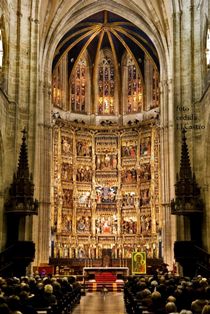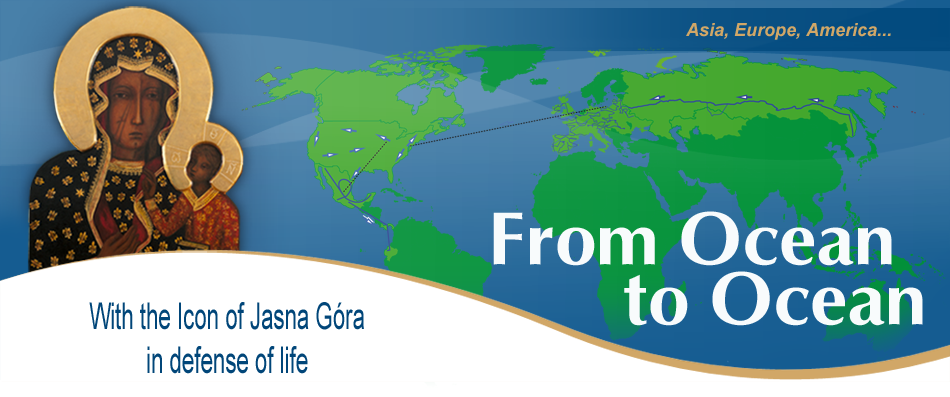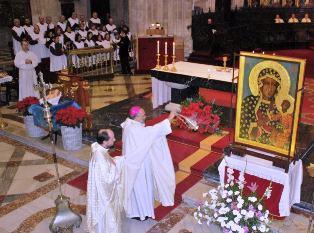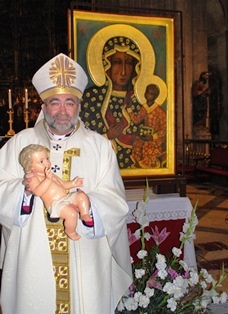On Sunday afternoon, at 5.15 PM, the Częstochowa Icon, peregrinating „From Ocean to Ocean” in defence of life, arrived at the capital of Asturia region – Oviedo, which is also the seat of the Archdiocese of Oviedo. The Mother of God was welcomed by Archbishop Jesus Sanz Montes, O.F.M. the metropolitan bishop of Oviedo.
God`s Providence made it possible for Our Lady of Częstochowa in Her Icon to spend the Sunday evening, the Christmas Eve and Christmas Day 2012 in the same cathedral which holds the Sudarion, the piece of cloth measuring approximately 84 x 53 cm, which was most probably used to cover Jesus Christ`s head after crucifixion. There is no image on the cloth (unlike the Shroud of Turin) but there are stains of blood and plasma. It is called the Sudario or towel of Oviedo.

In Oviedo the Icon of Our Lady came to the cathedral whose oldest fragment, dating back to the beginning of the 9th century, creates a two-level crypt. Inside it there is the so called Camara Santa (the Sacred Chamber)- a treasury, where the Sudarium of Oviedo, the Cross of Victory, carried by Don Pelayo, the first king of Asturias, at the victorious battle of Covadonga, and many other relics and historical items are held.
The first mention of the existance of the Sudarion appeared in 570, as it was held in a monastery of St Mark in Jerusalem. In 614, when Persian king Chosroes II`s invaded the Byzantine Empire, the Sudarion was taken away to North Africa, and due to further danger of the Muslim attack, it went with the refugees as far as Asturia. Since the middle of the 9th century it has been continuously held in Camera Santa – the chapel built for the purpose by king of Asturia Alfonso II. Nowadays it is presented to the pilgrims three times a year.
The Sudarion of Oviedo is one of the most precious relics of Jesus` crucifixion. The Holy Scripture describes it in the following way: "Simon Peter, following him, also came up, went into the tomb, saw the linen cloth lying on the ground, and also the cloth that had been over his head; this was not with the linen cloth but rolled up in a place by itself." (John, 20,6-7)
During the studies in the 20th century the researchers closely observed the cloth in ultra-violet and infra-red rays. The stains seem to be parallel as the cloth was folded when put on Jesus Christ`s head still on the cross, and next tied at the back of the head. During crucifixion they used to cover the convict`s head with a piece of cloth to cover the face in agony from the stare of those around. The latest research shows that the cloth was put on Christ`s head when He was still alive, still on the cross, which coincides with the traditional story from Oviedo.
The cloth shows openings surrounded by bloody stains which is another proof of the cloth`s authenticity because Jesus was the only one crucified in a crown of thorns.
The Law of Moses prohibited the spilling of blood so it could not fall on the ground. When Jesus was being taken down from the cross, when the position of the body changed, the blood poured out of His mouth from the lungs. The bleeding is supposed to have lasted about 15 minutes. So the cloth was taken from Jesus` head and covered His face to let the blood sink in. After the bleeding stopped the cloth was probably taken off. Then the Most Holy Mother could contemplate the Face of Her dead Son and dry, and balm it. Later, in a great hurry, as Sabbath was coming, the body was wrapped in a big shroud and placed in a grave. The blood-stained cloth was not fit to be put directly on the face, as it was the custom, but in accordance with the Law of Moses it was certainly placed in the grave beside the body, as it is described by St John. Therefore it was a silent witness of Jesus Christ`s crucifixion, His death and Resurrection.
If the cloth had been put on the face, the face of dead Jesus Christ would have appeared on it, and the Shroud of Turin would have had the remaining parts of the body marked without the face. When the researchers used the modern Polarized Image Overlay Technique they found that 70 spots on the forehead and 50 on the cheeks of the face on the Sudarion coincide with the image of the face on the Shroud. Therefore the images are identical in all details. Moreover the researchers managed to measure the length of the image of the nose. It proved to be identical with the nose length of the Man from the Shroud. The same coincidence occurs with the shroud (veil) from Manopello, which was probably placed on top.
Despite the fact that various evidence proves the authenticity of the Sudarium of Oviedo, we should remember that the belief in the relic`s authenticity is not the dogma of our faith. Nobody is able to say that the Sudarium of Oviedo, the Shroud of Turin and the Veil of Manopello are certainly authentic. Nobody is able to say they are not authentic either. The mystery of these shrouds has been fascinating humanity for years and the scientific studies only make people more excited. For many Christians they are witnesses of the Passion and Resurrection, and this is why they are cherished and surrounded with prayers.
The visit of the Częstochowa Icon in the Oviedo cathedral during Christmas connects the time of Jesus` birth and His death in a particular way. In Bethlehem the Virgin Mary wrapped the new-born Son in swaddling clothes and placed him in a manger. At Golgotha, the cloth or towel was wrapped around the head of Jesus on the Cross; after the Descent from the Cross, it would have been removed, possibly by the Most Holy Mother herself, and was placed in the Holy Sepulchre.
The Czestochowa Icon stayed in Oviedo from 5 PM on Sunday, the 23rd of December, throughout the Christmas Eve and Christmas Day, taking part in celebrations. Big crowds attended them and a lot was said in support of pro life movement, particularly by Father Benito Galli, the Pastor of the Cathedral. It was an exceptional Christmas marked with warm and tender presence of Our Lady of Czestochowa.
On the 26th of December she went to the seaside again to visit La Coruna in the Spanish region of Galicia.







